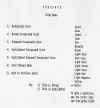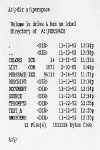 Under ordinary circumstances, it is expected that Phases 1 and 2 will require
no more than one hour, each, to complete. In most cases, both phases can be
performed in an hour or so.
Under ordinary circumstances, it is expected that Phases 1 and 2 will require
no more than one hour, each, to complete. In most cases, both phases can be
performed in an hour or so.
The predefined limits of 35 targets and 7 descriptors per target should be more than adequate to assessment needs. Note, however, that if subjects generated 7 unique descriptors for each target (arguably an unlikely eventuality), these limits would yield a target-by-descriptor matrix consisting of 8,575 (35 targets x [35x7 = 245 descriptors]) cells, each of which must eventually be filled in during the Rating session. At the rate of one rating per second, it would take a subject 143 minutes, or almost 2-1/2 hours, to complete Phase 3. Most subjects, of course, will require somewhat more time than this to make their ratings. Accordingly, operators may wish to set informal limits on subjects' responses.
PERSPACE requires that the generation of targets and descriptors be completed in one sitting. However, for the reasons just cited, rating every target on every descriptor can get a little tedious. Therefore, Version 3.5 allows subjects to take one or more breaks in the midst of a target-rating session without spoiling the response latency data, and even permit termination of a session and its resumption at a later time.
When the session is resumed, the Operator receives a warning, and the program continues to collect data at the point where it had been interrupted.
The target-descriptor pairs are presented for ratings in random order. The sequence of presentation is recorded in the RATINGS.DAT, VIEW.DAT, and DATA.RAW matrices.
Finally, it should be noted that some (but apparently not all) PC-compatible computers allow subject sessions to be terminated precipitously by pressing CONTROL-BREAK or CONTROL-C. Operators are advised not to inform subjects expressly of this fact; else, paradoxical intention on the part of the subject is likely to lead to disaster. Of course, nothing can prevent a determined, computer-wise subject from mucking up the system. Still, with the provision of breaks in the rating session, such an accident will have no long-term consequences: when restarted, the system will pick up where it left off.
PERSPACE 3.5 is designed to collect data from only a single sequence of three phases. For example, a subject might be asked to list, describe, and rate all of the important people in his or her life. However, there are circumstances under which more than one sequence of data-collection will be desirable. For example, subjects might be asked to work with more than one set of targets (e.g., to list, describe, and rate situations as well as persons; or to describe a single list of targets on more than one dimension (e.g., descriptions of an event and how that event made the subject feel); or to rate a single list of targets on more than one set of descriptors (e.g., subject-generated and experimenter-supplied; or to rate the same targets, on the same descriptors, on more than one occasion (e.g., before and after therapy, or some significant life-event).
Note, however, that restarting a Target, Descriptor, or Rating session (except, in the case of Rating sessions, a planned interruption) will effectively delete the corresponding data files created during the last such session.
For this reason, it is recommended that at the conclusion of each assessment (i.e., at the end of Phase 3), data generated by the Subject be backed up and retained permanently. The appropriate files then can be copied for second and later uses. As with any other software system, the best advice is to backup the data files.
 PERSPACE is designed to be run on a color monitor, and permits a wide variety
of color choices for background, foreground (normal and enhanced), and
highlighting.
PERSPACE is designed to be run on a color monitor, and permits a wide variety
of color choices for background, foreground (normal and enhanced), and
highlighting.
After making a selection, quit to the previous level of the Operator Menu.
Note that changing the screen color affects every part of the program except that which changes the screen color itself. This is intended to prevent accidentally rendering the screen unreadable.
On the IBM PS/2, a total of 16 choices are available for foreground and highlighting. A subset of 8 of these are available for the background.
The effect of the current choice is demonstrated at the bottom of the Color Menu screen.
 PERSPACE contains two different kinds of files. System files run the
procedure, and are distributed among three different subdirectories. Subject
files contain data generated by the subject, and are stored in a fourth
subdirectory that is created by input of identifying information by the
Operator. On the distribution disk, these subject files pertain to the
demonstration subject discussed below.
PERSPACE contains two different kinds of files. System files run the
procedure, and are distributed among three different subdirectories. Subject
files contain data generated by the subject, and are stored in a fourth
subdirectory that is created by input of identifying information by the
Operator. On the distribution disk, these subject files pertain to the
demonstration subject discussed below.
Also, the distribution disk contains, in a fifth subdirectory, BMDP job control language, and statistical analysis output, generated by the demonstration subject.
The following system files are found on the installation disk and must be present for the PERSPACE program to work properly:
In Subdirectory PERSPACE
| PERSPACE.EXE | This is the PERSPACE Program |
| COLORS.SCR | Contains the user's selected Screen Attributes |
| LIST.COM | Public Domain Listing Program |
In Sub-Subdirectory PERSPACE\TPROMPTS
| KELLY.PER | Categories of Persons Suggested by Kelly (Kelly, 1955) |
| KELLY.EVE | Categories of Episodes Suggested by Kelly (Kelly, 1955) |
| ROSENBER.PER | Categories of Persons Suggested by Rosenberg (Rosenberg, 1977) |
| MAYMAN.EVE | Categories of Early Recollections Suggested by Mayman (Mayman, 1968) |
| PERVIN.SIT | Categories of Situations Suggested by Pervin (Pervin, 1976) |
| FREELIST.PER | "Please list all the Important People in your Life" |
| FREELIST.EVE | "Please list all the Important Events in your Life" |
| FREELIST.SIT | "Please list all the Important Situations in your Life" |
These target lists are described in detail in Appendix 1.
Note that the original set of PERSPACE target prompts supplied on the distribution disk is dated 07/10/90. Users of the system are, of course, free to revise these files as convenient.
In Sub-Subdirectory PERSPACE\DESCRIPT
These descriptors are described in detail in Appendix 2. Note that the original set of PERSPACE descriptor prompts supplied on the distribution disk is dated 07/09/90. Users of the system are, of course, free to revise these files as convenient.
In Sub-Subdirectory PERSPACE\DOCUMENT
| USER.MAN | this document (WordPerfect 5.1) |
Note that a shortened version of the official PERSPACE user manual, PERSPACE.WEE, supplied on the distribution disk is dated 11/22/92. The version supplied lacks representations of the screens and certain other illustrative material.
The distribution disk may also contain the Turbo Pascal source code for PERSPACE, thus permitting programmers to make modifications to the system. These files are stored in a separate subdirectory.
In Subdirectory PERSPACE\SOURCE:
| PERSPACE.PAS |
| OP_UTILS.PAS |
| SUB_UTIL.PAS |
| UTILS.PAS |
Note also that three other files are created when Turbo Pascal compiles these four files into an executable file (PERSPACE.EXE):
| OP_UTILS.TPU |
| SUB_UTIL.TPU |
| UTILS.TPU |
These three files are not necessary and have been deleted.
In addition to the system files, the following subject files are stored a subdirectory that is created for each individual subject on the chosen drive. The name of the Subdirectory is formed by using the first six characters of the Subject's last name, followed by an underscore and the first character of the Subject's first name. The files are generated by the system to capture the necessary data generated in the session.
In the Subdirectory created for each Subject
| SUBJECT.INF | Information entered in the opening screen and/or updated later |
| SETTINGS.INI | Initial settings used by the system to keep track of files, variables, etc. |
| TARGET.INP | Prompt file used for inputting Targets |
| TARGETS.SUB | Targets generated by the Subject |
| TARGETS.RAT | Edited set of Targets used by the Program for rating by the Subject |
| DESCRIPT.SUB | Descriptors generated by the Subject |
| DESCRIPT.ED | Edited set of Descriptors |
| DESCRIPT.RAT | Descriptors used by the Program for rating by the Subject |
| RATINGS.DAT | Target X Descriptor Matrices of Ratings, Response Latencies, and Order of Presentation |
| VIEW.DAT | Contains the data found in Targets.SUB, Descript.SUB, and Ratings.DAT |
| DATA.RAW | Same as in Ratings.DAT, except rotated and unformatted and ready for export to a statistics package |
An example of a VIEW.DAT file is provided in Appendix 3.
This page last revised 04/08/10 02:58:48 PM.